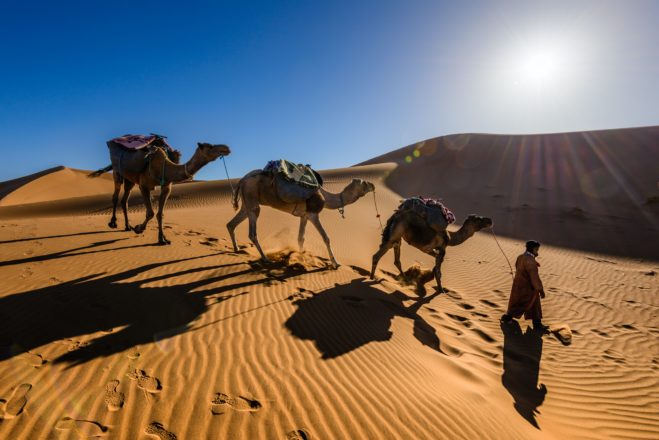
We’re may not be historians at Become Nomad, but today we’re taking a big-picture, historical look at the evolution of nomadism.
Because understanding where we are and where we’re going is hard without knowing where we’ve been.
Listen to the full pod here:
Wanna hear more? Subscribe on Stitcher, iTunes, Spotify, or wherever!
In the beginning, nomadism was humanity’s norm
This itself is pretty interesting, that nomadism is our origin. Back in the period of hunters and gatherers, modern-day nomads would probably find a way to thrive.
Back then, at a time when humanity had a low global population closer to one million, people organized themselves into smaller, spread-out communities. Groups of up to 100 or so would depend on each other and live cohesively.
You would wake up, find food, hunt something, and eventually drift elsewhere. It was a great time for nomad freedom, but obviously it came with many disadvantages: The dangers of even the mildest infections, shorter life expectancy, minimal certainty of safety. And minimal certainty of anything, really.
But it was an interesting period to be alive all the same: This uncertainty and openness likely translated into lots of spirituality because there was no noise, no technology, and no other attachments to distract. All these people had was thinking and more thinking – to a degree that we don’t have today. Sure, we may have heightened intelligence and knowledge… But we likely don’t have their level of open thought and spirituality.
The evolution of nomadism is a transition towards security and comfort
So we have this concept of purely nomadic communities that moved together out of necessity. If food got scarce or weather became unfavorable, they all moved together to best handle those circumstances.
Hunters and gatherers had small communities that took more direct care of one another… And also had to deal with more sensitive internal politics. But they fulfilled a basic need of community on a higher level than what we have now.
Today, we’re still social animals but we’re relatively more alone. That sense of community has kinda been replaced by the nuclear family. And our original tribal nature has eroded and become replaced by other less personal forms of community: Sports teams, nationalities, etc…
What went wrong? Or, depending on how you look at it, what went right? Either way: What changed?
What happened was this: We started leaving this lifestyle because we had something to lose. The idea here is that basic technological advancements – creating fire, harvesting wheat, farming animals – created attachments. In turn, it enabled people to settle down in one location.
So we might have lost a lifestyle that was optimal for our happiness and well-being for a lifestyle that allows more certainty and safety with the caveat of more attachments and obligations.
Much like what we’ve discussed with modern nomadism, the minute these attachments pop up, you lose the flexibility of mobility. Whether our ancestors realized it or not, these attachments came with a big price. And it’s not clear that this was a purposeful decision; it seems that these attachments naturally crept into nomads’ lives to the point where the alternative cost and fear of losing certainty got too big.
This ties to the idea of loss aversion that Daniel Kahneman once popularized: The pain we experience when we lose something is much greater than the joy of receiving the equivalent out of the blue.
And maybe that’s actually why we’ve survived as a species. We’ve evolved to be risk-averse and to avoid losing things in an effort to keep us safe. Human psychology thus makes it inherently difficult to break free of attachments.
Another interesting way to look at it is that these attachments actually acted on and domesticated our species. In his book Sapiens, Yuval Noah Harari notes how wheat used us as a tool – it took away our freedom to make itself become the most important plant. In a way, it forced our attachment to it to benefit its own evolution. And we obliged.
The evolution of nomadism always featured some rebels with a cause
Even as people started to settle, there were a handful of rebels. Buddhists in particular made notable efforts to disconnect from this societal trend. (And, interestingly, they often did so in groups; the Buddha himself ended his nomadic life with hordes of followers at his side).
Tribes that kept a nomadic rhythm to their lives – the Irish Romani or the Arab Bedouins, for instance – quickly became outcasts. When you move around like they did, sedentary societies don’t trust you.
And now, a lot of these tribes have been domesticated. Partially due to valuable attachments but also due to the social price you pay as a nomadic group. And this price often comes with good reason – your efforts to preserve your lifestyle might clash with those building a sedentary lifestyle.
These implications of being nomadic when most people are non-nomadic are extensive. Most prominently: The waves that pulled us away from nomadism benefited those who emerged in charge. In a sedentary world, controlling nomads is harder because of both their free movement and spirit.
One interesting case study is the Zen monks of Japan. As Alan Watts has talked about extensively, these people’s primary motivation was moving around and asking questions of different people in an effort to reach greater answers about life. This isn’t exactly a group of people that sedentary leaders are going to have an easy time forcing to conform…
Avoiding the “outcast” label as a nomad throughout history
The nature of attachments is that the cage gets bigger and stronger the more technology progresses. This cage takes the form of large social structures – think cities, nation-states – that effectively keep you grounded.
Throughout the evolution of nomadism, people who were rebellious but didn’t want to be outcast found other ways to satisfy the nomadic urge (much like how many digital nomads do now). Yeah, they were adventurously moving around the world, but there were justifiable reasons backing them up. These sorts of people used to be the Marco Polo-esque diplomats, the well-traveled merchants, and even the ambitious missionaries of the world.
There were and still are a few ways to run away from the structured, isolated, urban, Netflix lifestyle and still look “sane,” like you’re still part of society. You can stay part of the game but maintain your under-the-radar beliefs and support a lifestyle that satisfies deeper spiritual desires. That’s digital nomadism in a nutshell.
So what’s killed the evolution of nomadism?
If you look at how tech has gotten better and nation-states have gotten more powerful, you’ll see that nomadic groups have become marginalized. And then they dwindle.
For these nomads, not playing the sedentary-lifestyle game proved to be unsustainable. But when they joined the game, they found themselves at a disadvantage of coming late. In a way, this vicious cycle has stamped out nomadism.
In today’s sedentary-heavy world, the guiding principle of the modern world with all of its attachments and higher standard of living is “You’re not there yet.” You’re not there yet as a kid since you need schooling. But after even higher education you still need a job. And then you still need to grow this career and build a family and buy a home. And even then you’re not there yet because you need more money for your retirement and for your children’s future. Etc… etc…
Our entire society is built on status games where the main rule is “You’re not there yet.” Alan Watts really articulates this point: When you finally are there, at age 80 or so, it’s too late to do most of the things you wanted to. It’s not a revolutionary idea anymore, but it’s simply the truth of how our modern society works.
And, as we’ve said before, this isn’t a bad thing! We’re not against the status quo; the status quo has emerged for a reason. And it’s probably the optimal lifestyle for 90 to 95 percent of humanity. But… Maybe it doesn’t have to be for you.
And just by reading this site and listening to our podcast, it means that in some sense you’re looking for something else. This thing might not exist or it might be too difficult to achieve, but at least you realize you might be on the edge of that 95 percent.
So here’s the question: What do we do? And we don’t necessarily have the answers. But maybe, forming and merging yourself into the status quo is not your best-case scenario.
The double-edged sword of technology
Let’s look at this next phase in the evolution of nomadism. While technology has boosted the attachments that have pushed people towards sedentary lifestyles, it has also given us some freedom to pursue a nomadic path. (To be clear – tech has definitely done more against nomadism, but we’re currently seeing that shift).
As for the subset of digital nomadism that has emerged, many don’t consider it real nomadism since we’re attached to our work and have similar attachments, only in the virtual world. It’s like we’re leading a double life, and we’ll actually talk about this more in a future episode.
But tech has allowed us to disconnect from our location. To be self-sustainable but also location independent. And now, interestingly, Covid-19 has further challenged this model by showing us the importance of our base countries.
But the big idea is that tech is now giving us new tools to enable nomadic living. How to do it in the best way possible – particularly post-Covid – is another story.
Where the future of nomadism might go beyond our lifetimes
Get ready for some big-time conjecture here
I see three futuristic paths that may emerge as the evolution of nomadism continues . And naturally, a fourth path we don’t see is likely to be what happens.
The first path: A “meta-verse.” Coined by writer of Snowcrash, an interesting cyber-punk book that we heavily recommend. And the idea behind it is that the virtual world will become much more powerful than it is today… To the point where subsets of nomads reject the overly-structured physical world and transition to the virtual world.
I think it’s safe to say we all hope this artificial, simulation-heavy reality doesn’t become our norm. But it’s already kinda happening. Either via RPG games or other online tribes, many people – especially in younger generations – are trending down this path. And it’s not crazy to envision that nomadism will overlap with it.
One has to wonder, by the way, why even the lowest-quality RPG games from the 80’s were so addictive. Some inner psychological bug or some outer societal bug seems to always push people towards escaping towards other realities.
The second path: Space. It surely won’t be in our lifetime, but future nomads who get bored with this commercialized world might have the chance to travel beyond our planet and continue mankind’s need for exploration.
It won’t be for us, and it may sound like Sci-Fi, but if current humanity gets its act together, it may be our grandchildren’s grandchildren’s reality.
A more reasonable third path, though, is one on Earth. If a more deadly pandemic or a catastrophic global war breaks our existing society down, we may just have to restart at nomadism to deal with the uncertainty and lack of structures (… probably in a much sadder reality than our hunter-gatherer ancestors did).
So there you have it: Some random thoughts the evolution of nomadism. Many things here are obviously subjective and conjectural, but we think it’s important to form some understanding to better plan for our future.



0 Comments